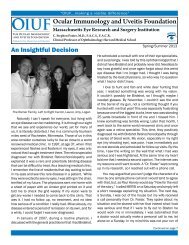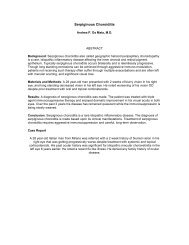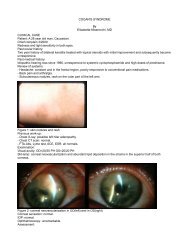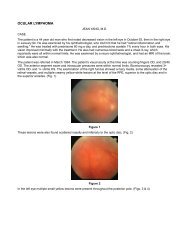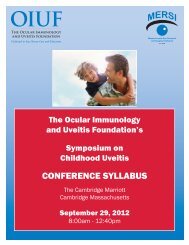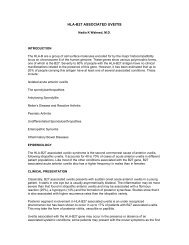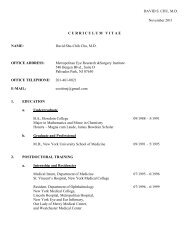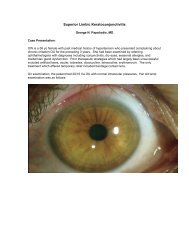measles.pdf (75.47 KB) - Ocular Immunology and Uveitis Foundation
measles.pdf (75.47 KB) - Ocular Immunology and Uveitis Foundation
measles.pdf (75.47 KB) - Ocular Immunology and Uveitis Foundation
Create successful ePaper yourself
Turn your PDF publications into a flip-book with our unique Google optimized e-Paper software.
PATHOGENESISThe <strong>measles</strong> virus belongs to the genus Morbillivirus in the Paramyxoviridae family. It has an RNA core <strong>and</strong> ahelical capsid. The size of the virion is 100 to 200 nanometers in diameter. It is highly contagious. The first contactis at the mucous membrane of the respiratory tract. The conjunctiva also might act as a portal of entry for <strong>measles</strong>.If not inactivated by mucus or specific secretory IgA antibodies, the virus enters the ciliated columnar epithelium.During the primary viremia, two to six days after the infection, the virus is transported intracellularly inside theformed elements of the blood. A second viremia begins 10 days after the infection, with proliferation of the virusinside leukocytes. Neutralizing antibodies appear 14 days after infection, at the time of the appearance of the rash;rash is an expression of immunologic defense. In patients with severely impaired cell-mediated immunity, a<strong>measles</strong> infection may run its course without the appearance of rash. The <strong>measles</strong> antibodies cross the placenta<strong>and</strong> protect the infants against infection for the first six to twelve months of life.DiagnosisDiagnosis of <strong>measles</strong> is made by observing the regular sequence of the prodromal phase, the appearance ofKoplik’s spots <strong>and</strong> the generalized rash. The <strong>measles</strong> virus can be recovered from mucus membranes, urine, <strong>and</strong>blood for a few days before skin eruption <strong>and</strong> one or two days afterwards. The virus can be obtained from the urinefor an additional few days. Serum antibodies can be detected within one or two days after the onset of the rash.During the prodromal phase <strong>and</strong> early eruptive phase of <strong>measles</strong>, multi-nucleated giant cells with eosinophilicinclusions in both the nuclei <strong>and</strong> cytoplasm can be identified in sputum, nasal secretions, or urine. In electronmicroscopic studies, inclusion bodies are visible as granular masses, with the characteristic measurements of theRNA helix.TREATMENTUncomplicated <strong>measles</strong> infection is a self limiting disease. Supportive treatment is usually satisfactory enough. Thecourse of <strong>measles</strong> infection can be altered by treatment with gamma-globulin as soon as possible after exposure.After six days of exposure, the treatment with gamma globulin may not prevent or modify the disease.For the ocular manifestations, treatment is also symptomatic. No specific treatment for uveitis is described in theliterature.ComplicationsThe most serious complications of <strong>measles</strong> are those affecting central nervous system <strong>and</strong> heart. The incidence ofacute encephalitis in <strong>measles</strong> patients is 0.1%. It usually appears 6 weeks after the onset of the rash. Of thesepatients, 10 to 25% die, <strong>and</strong> 20 to 50% of the survivors suffer from permanent neurologic damage. Other centralnervous system complications include subacute <strong>measles</strong> encephalitis, toxic encephalopathy, retrobulbar neuritis,transverse myelitis, <strong>and</strong> ascending myelitis. SSPE is a late complication of <strong>measles</strong> affecting the eye discussedlater.The keratitis can become ulcerative in patients with secondary bacterial infections or in debilitated patients withconsequent corneal neovascularization, or it may become purulent, with progression to corneal perforation,panophthalmitis, <strong>and</strong> phthisis bulbi. These severe corneal ulcer complications are most frequent in developingcountries as a consequence of malnutrition, vitamin A <strong>and</strong> protein deficiencies.PrognosisThe prognosis of <strong>measles</strong> in vaccinated populations is good. In less developed countries approximately 1% ofchildren with <strong>measles</strong> end up with permanent ocular damage. The term post <strong>measles</strong> blindness (PMB) is restrictedto the corneal complications of <strong>measles</strong>, although retinitis <strong>and</strong> optic neuritis have been also described as a cause ofdamage to the sight after <strong>measles</strong> infection. In West Africa, 43 of 193 blind children were blinded by <strong>measles</strong>.Interestingly, in one study 10 of 13 patients with uveitis associated with multiple sclerosis had elevated levels of<strong>measles</strong> IgG antibodies in the anterior chamber fluid.Subacute sclerosing panencephalitisEpidemiologySSPE is a chronic degenerative disease of the central nervous system, first described by Dawson in 1933. Itsprevalence has been estimated at 1 to 10 per 10 million cases of <strong>measles</strong>. The male to female ratio varies from1.8:1 to 4:1. The onset of SSPE is usually 6 to 7 years after <strong>measles</strong>. Individuals who had <strong>measles</strong> before the ageof two years are of higher risk of developing SSPE. The majority of patients manifest neurologic signs before theage of 20 years.Clinical symptoms



